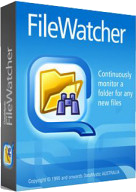
FileWatcher continuously monitors one or more folders for new files. When new files arrive, FileWatcher then triggers a custom action, such as running a second program with the new files.

FileWatcher can be run as a Windows service using FireDaemon Pro. This allows you to start and run the dedicated server automatically when Windows boots and before login. FireDaemon Pro also allows you to start multiple instances of the application, monitoring them and automatically restarting those instances in the event they crash. FireDaemon Fusion can also be used to manage your FileWatcher service, plus other Windows services via your web browser.
FileWatcher Server Setup Under FireDaemon Pro
Please follow the steps below to set up a FileWatcher as a Windows service with FireDaemon Pro
Step 1: Download and Install FileWatcher
- Download FileWatcher. A single exe file filewatcher-cr.exe is downloaded.
- Double-click filewatcher-cr.exe and install it. By default it installs to C:\Program Files\DataMystic\FileWatcher folder.
Step 2: Download and Install FireDaemon Pro
Download FireDaemon Pro installer
- Double-click installer and follow the installation wizard to complete the installation.
- For more information about installing FireDaemon, see the FireDaemon Pro Users Guide.
Step 3: Set Up FileWatcher as a FireDaemon Pro Service
Double click the FireDaemon Pro icon on your desktop, then click on the New (i.e. +) button in the toolbar (or type Ctrl + N) to create a new service. Enter the information into the fields as you see below. Adjust the path names to suit your installation. Note the required parameters.

The most important field on the tab is the Parameters. The Parameters define the initial setup of your server. The full parameter list should be as follows:
/f="C:\FileWatcher Settings\mysettings.fwx" /g
- "/f="C:\FileWatcher Settings\mysettings.fwx"" loads a specific settings file.
- "/g" begins watching immediately when the FileWatcher service is started. If this parameter is missing, FileWatcher will not start checking when the service is started.
The default save path for settings is in "C:\Users\USERNAME\Documents\DataMystic\File Watcher". If your settings file is located in a users folder, then the service must be run as adminstrator. If you put the settings file in another location such as "C:\FileWatcher Settings" then you can run the service without specifying a logon acount.
Next, click on the FireDaemon Pro Settings tab:

Enter appropriate values in the fields on the Settings tab as follows:
- Logon Account: Enter the Windows account under which the application is to be run, e.g. the current user account.
- Password / Confirm Password: Enter the logon account's password twice.
- (Optional) Interact with Desktop: If this setting is enabled (default), the application's output messages can be seen in the console window on Windows Session 0. To switch to Session 0, it may be necessary to install FireDaemon Zero and ZeroInput. Alternatively, this setting may be disabled, in which case the game server's messages will be hidden.
- (Optional) Priority: To allocate more CPU time to the application, select a higher scheduling priority in this field.
- (Optional) CPU Bindings: To run the application on a specific CPU, specify the appropriate CPU in this field.
Next, click in the Lifecycle tab. Set Shutdown By to Forceful Termination.

Lastly, click the Save and Close (ie. the tick) button on the toolbar. If the service's Startup Type is set to Automatic or Automatic (Delayed-Start), it will start immediately.
Step 5: Verify that FileWatcher is Running Correctly
FileWatcher's status can easily be checked on the main FireDaemon Pro Services List - look for a Running Status value and a numeric Process ID (PID) value.

If the service's Interact with Desktop setting is enabled, the application can also be verified by switching to Windows Session 0 to view the application's messages.

